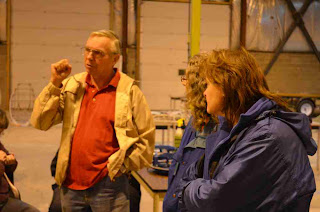Only Air Ship in Canada
Dr. Barry Prentice and Dale George presented the only air ship in Canada to the Recreational Aircraft Association (RAA), aviation enthusiasts, and Lyncrest Neighbours! Barry and Dale explained what's the difference between a blimp? dirigible? air ship? - nothing, they are all non-rigid lighter than air vessels. Whereas the Zeppelin has a frame. The air ship bag weighs about 400 pounds, is about 80 feet long, and can carry about two people. Like an ocean-going ship, the larger the air ship is it can carry and exponentially greater load. To carry 5 people, one needs about 140' bag or envelope.
Home Built with 500 yds of fabric!
Dale and Barry inflated their air ship for our tour. Dale actually built it using about 500 yards of 56" wide fabric and about two dozen helpers. The seams are sewn with a standard sewing machine and sealed with heat and glue to prevent leakage. The fabric is very strong, gas tight, and has a UV stabilant on the outside. The fabric weighs 10 ounces/sq yd, it's not light, therefore Dale plans to experiment with light weight aircraft grade aluminium as a substitute for fabric. The envelope is actually two bags, one inside the other.
Helium vs Hydrogen
The bag is filled with helium; however helium is currently being rationed so Dale and Barry are experimenting with hydrogen. Next door the New Flyer Bus manufacturers are soon to release a hydrogen powered bus, Dale and Barry expect to follow similar safety practices to use hydrogen for their air ship. They plan to begin testing with remote controlled, unmanned air ships.
How to Fly an Air Ship
How does one learn to fly an air ship? Dale learned by actually buying a $2.5M dollar machine and learning to fly it in the USA. After about 20 hours of training he was flying solo! Some of the surprise features included on C-IJOR are:
1. It doesn't stall!! Even at a 80 degree angle climb, impossible to stall
2. Because the cockpit is in the centre of the air ship, when instruments indicate the machine is 1/2 degree off straight and level, the nose might be as much as 50 feet high or low!
3. The air ship 'sails' through the air rather than bouncing around like fixed wing aircraft in turbulence.
4. When placed into a steep dive, it doesn't speed up if it encounters cool air!
5. An engine failure is uneventful as the air ship will hover for hours. Once can shut engines off, let a passenger out on a rope ladder, and then help them back up the ladder an hour later without landing!
Restoring a larger Air Ship
A larger air ship, 140' long, is currently having its fins recovered with Polyfiber aircraft fabric. Once recovered, the pieces will be tied into position using specially designed knots and fine rope! The fabric is glued, taped, and ironed. No rib stitching is used. Dale said, air ships are typically painted with rollers on the end of broom handles! It was fascinating to see how the air ship components were assembled, numerous RAA members agreed it would be really interesting and fun to help restore a few of the pieces in a work party. AME's have agreed to supervise the work. Dale and Barry will provide all the materials, gas to cover volunteer's travel costs, plus rides in the air ship once it is finished!! On a stormy winter Saturday, guess where you'll find a group of aircraft builders keen to try their skills on recovering an air ship fin!! If you're interested in joining Jim Oke's team of volunteers, contact jill_oakes@umanitoba.ca with when you are available.
The following are a few photos of C-IJOR:
These are the fin's to be restored with PolyFiber, glued in place, shrunk with an iron and tapes added.
Dale George explaining how to fly an Air Ship! with Bill Hilash looking on.























No comments:
Post a Comment